TCM Film Festival Wraps With Focus on WB at 100 and Screen Sirens of the ’60s
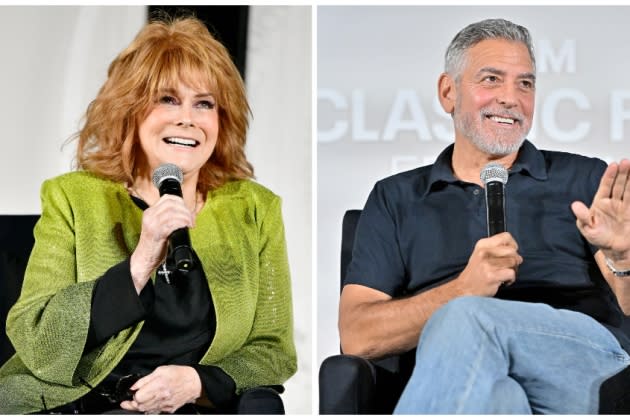
If the 14th annual TCM Classic Film Festival had an official focus, it was on the 100th anniversary of Warner Bros., from the opening night premiere selection of a restoration of “Rio Bravo” to a celebration of the 50th anniversary of “The Exorcist.” Almost equal in emphasis, though, by virtue of the guests brought in, was a celebration of the ingenues-turned-leading-ladies of the 1960s, who now represent the elder guard of a Hollywood golden age — Angie Dickinson, Ann-Margret and Shirley Jones.
Dickinson had the highest profile of any star at the festival, being the belle of the ball at the Thursday screening of “Rio Bravo” in the big house at the TCL Chinese Theatres, where most of the screenings were held. But there was just as much outpouring of affection for Ann-Margret, who turned up for a Q&A (and birthday cake) following “Bye Bye Birdie” on Saturday, and Jones, who was joined by her son Shaun Cassidy and a slew of grandchildren after a showing of 1962’s “The Music Man” as the festival neared its end Sunday.
More from Variety
Angie Dickinson Reflects on 'Rio Bravo' and Her Friendships With Frank Sinatra and Rock Hudson
George Clooney to Direct Showtime Political Thriller Series 'The Department'
Other guests that charmed passholders included several team-ups who sat for joint Q&As — Tom Berenger and JoBeth Williams for the closing night attraction, a 40th anniversary showing of “The Big Chill”; Richard Dreyfuss and Candy Clark, appearing together prior to a 50th anniversary presentation of “American Graffiti”; George Clooney and filmmaker Steven Soderbergh, sharing memories about 2001’s “Ocean’s Eleven”; Lou Diamond Phillips and Edward James Olmos, reunited for a 35th anniversary look at “Stand and Deliver”; Amy Irving and Peter Riegert summoning up the chemistry of “Crossing Delancey,” 35 years later; and, representing “The Exorcist,” director William Friedkin and the devil. (The latter did not turn up in the flesh, but appeared to get into the filmmaker a little during a characteristically irascible conversation.)
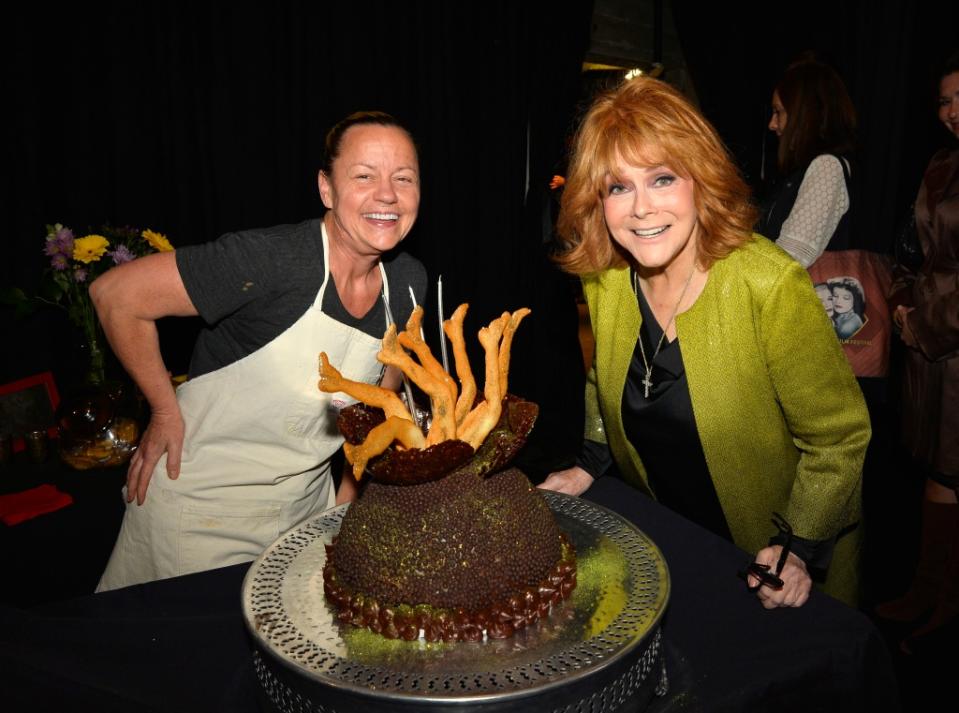
Ann-Margret turns 81 on April 28, and for an early celebration, celebrity chef Sherry Yard brought her a cake festooned with legs, in honor of the dance chops she showed off in the “A Lot of Livin’ to Do” sequence of “Bye Bye Birdie” and many films that followed. The screen legend took her time in blowing out the candles, saying, “I always make the same wish, but I never tell anybody what.”
The actress avowed that it did not seem like it’d been 60 years since “Birdie”: “Not at all. Why? I don’t know. I still have the energy that I had then.” (She has just released a new album, “Born to Be Wild,” which includes rockers Pete Townshend and Joe Perry as guests.) When TCM host Dave Karger asked about the disparity between her demure off-screen image and the wild moves that made her famous, she said, “There’s me, like right now, and then there’s another side of me.” “I’ve seen ‘Tommy’,” quipped Karger in response.
Asked if Elvis Presley, whom she next starred with in “Viva Las Vegas,” ever commented on whether he knew the Conrad Birdie character in “Bye Bye” was a parody of him, Ann-Margret simply said, “He had a good sense of humor,” probably meaning that they had better things to talk about by then.

As might have been expected, the pre-“Ocean’s 11” Q&A between Clooney, Soderbergh and TCM host Ben Mankiewicz proved the ideal combination of charm offensive and actual insight into the film business. The conversation first had a prelude in a discussion of the two guests’ initial collaboration, “Out of Sight” (which Mankiewicz enthusiastically hailed as one of his two favorite films of all time), and how uncelebrated both their careers were at that point (Batnipples inevitably being brought up by Clooney as the elephant nipple in the room). Even though the star reminded the audience at the Chinese that “Out of Sight” was a financial flop, great reviews left it perceived as a success, which three years allowed Soderbergh and Clooney to call in a lot more favors and ask top-name actors to go for what ended up being lucrative back-end deals on “Ocean’s.”
“We sent Julia (Roberts) a script and I wrote a note saying, ‘I hear you get 20 a picture now,'” recalled Clooney, “and we sent her a $20 bill … It made her laugh, and yes, she jumped right on board.” Not everyone did: “Some very famous people told us to fuck right off.”
The goal, after making some arthouse films, Soderbergh said: “It felt like the next iteration in my desire to work in the mainstream film business and make movies that could be released in a lot of theaters. I grew up watching movies made by great filmmakers that were commercially successful, distinctive movies, and I wanted to be part of that.” Added Clooney, “The studios were making really very big, broad, not very good films at that time. It was kind of an ugly period, and Steven had this idea of trying to infuse all of this sort of independent film stuff that all of these young filmmakers were learning back into the studio system. So it was gonna kinda get back to the things that they were doing from like 1964 to 1975, bringing that kind of style and feel back to storytelling inside the studio system.”
Without actually remaking “Ocean’s 11,” in much more than name, anyway, when what Soderbergh really wanted to do was spiritually remake a Robert Redford/George Segal picture from the 1970s. Asked about the Rat Pack-driven “Ocean’s,” since the 2001 pic was part of a TCM Fest series of remakes that were arguably better than the originals, Soderbergh delicately said, “The original seemed to me more notorious than memorable. There are things in it that are really valuable, in the sense of those people at that time, the shots of Vegas in 1960 at magic hour — there are things in it that make it worth returning to. I just felt that as a pure piece of narrative entertainment, the (contemporary) script I read really took that setup and put it on steroids… And it’s (effectively) ‘The Hot Rock,’ which is one of my favorite Donald Westlake books. It’s ‘The Hot Rock.'”
Asked if there was any talk of doing a fourth movie in the series — if no one counted the female-themed reboot “Ocean’s 8” as part of it — Clooney said, “I’ve had the talk. He doesn’t…. They killed me by the way, in (‘Oceans’s 8’)”, Clooney added, though he didn’t seem to find that an obstacle, personally. Soderbergh measured his words carefully, with a long pause: “I’m thinking about… tomorrow.” His star followed up that existential moment by reminding Soderbergh of how long he’d kept a more film series going: “You could mix them. There’s ‘Magic Mike.’ They have strip clubs in Vegas. ‘Magic Danny.’ Danny gets his groove.”
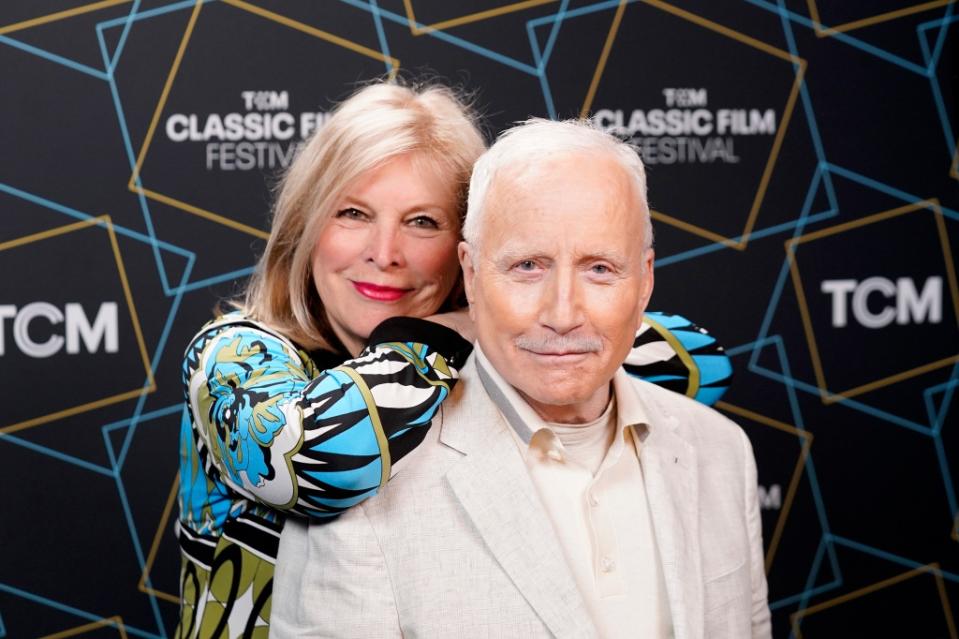
During the “American Graffiti” conversation, Candy Clark said the 50-year-old film is never far from her mind because “I do a lot of hod rod shows” where the movie’s evocation of early-’60s car culture is celebrated.
Said Dreyfuss of George Lucas, who had “Graffiti” as his second directorial effort (and his last that was not part of the “Star Wars” franchise), “George is the only director that I’m aware of who does not like being a director” — as opposed to a delegator. Not that the actor has any reason to knock him: “George Lucas is a rare bird … Without anyone asking him to do this, he took one of his gross points, one-tenth of 1%, and he divided it up among the 10 actors. And I have made more money from that one-tenth of one gross point than I’ve ever made on any movie.”
As acclaimed as the cast was, with nothing but future stars, Karger notes that Clark was the only member of the ensemble to get an Academy Award nomination. “I ran my own campaign, and, you know, I got some feedback negative, kind of like a few people that have copied my campaign,” she said, making note of Sally Kirkland, Melissa Leo and Andrea Riseborough as fellow actors who successfully launched DIY campaigns in lieu of bigger backers. “It’s show business, so I ran my own campaign. Universal wasn’t doing much for the movie. I spent a couple of thousand dollars and bought little quarter-page ads and, lo and behold, it worked. … Back then you dressed your own self to go to the Academy of Awards and did your own makeup, and it was one of the most exciting nights of my life. I recommend everyone to get nominated.”
Clark and Dreyfuss had clearly spent some time together prior to the screening and ribbed each other affectionately — including her noting how he was running out the clock on their 15-minute slot with the story of how he got discovered for the movie, and also, more sweetly, remembering that he was crying during the shoot because he’d just broken up with a girlfriend, something he was able to channel into his performance.
Asked about playing being in love with a Suzanne Somers he has only glimpsed through a car window, Dreyfuss said, “If you ask me to play being in love, it is like falling off a log for me. There are certain things that I do well. Falling in love is one of them.”
As the interview was being called for time, Dreyfuss said, “One last word. Two of our cast members have died recently: Cindy (Williams) passed away, and Bo (Hopkins). It was going to go unacknowledged, and when we were talking last night, I said we shouldn’t let that happen because we were a tight group and we felt a real bonding and we shouldn’t let go. So I said to Candy, ‘I said, ‘Why don’t we observe a moment of silence?’ And she looked at me and she said, ‘That’s too serious, because we’re gonna burst into laughter.’ And I said, ‘OK, let’s do that.’ So I’m gonna say that in honor of Cindy Williams and Bo Hopkins — and everyone else is gonna drop dead in the next few years! — I would like us all to observe a moment of silence.” That indeed transpired inside the Chinese, before Dreyfuss broke it up with the signature cackle most audiences first heard in “Graffiti.”
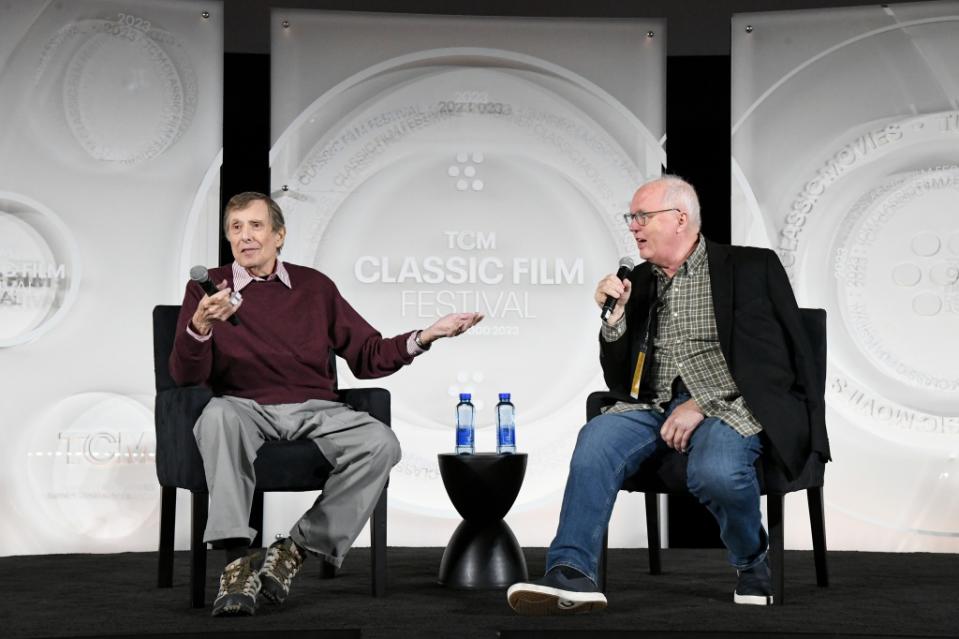
In the post-“Exorcist” Q&A, interviewer Randy Haberkamp noted that, on the list of the 100 biggest-grossing Warner Bros. films of all time, “The Exorcist” was the only film from the ’70s or ’80s that made the list without any adjustments between 1973 and 2023 dollars. Therefore, “in my opinion, I think this is their most successful film,” Haberkamp said. Director Friedkin’s immediate irreverent response was to say that the studio “is screwing me” and wonder if there were any good lawyers in the house — probably jokingly, although with Friedkin, it’s not always 100% clear.
Told that the film stands the test of time in a way few movies do, the director said, “That’s really important to me to hear that. Thank you very much. Because I barely remember the experience. I’ll see if we can poke around and get some memories.” No stories about the making of the classic were forthcoming, although Friedkin did spend a great deal of time extolling the original novel and subsequent screenplay by William Peter Blatty… before ultimately devoting more of the conversation to his awe for “Citizen Kane” than to his own filmography, of which he said that the worst and best films he’s made pale by comparison.
Known for his rare but always entertaining Q&As, Friedkin was in a sometimes jocular, usually contrary mood at the Chinese. “I don’t know what the hell you’re talking about” was a typical first response to a question. When Haberkamp offered up the contention that “I don’t call this a horror film,” saying he believed Friedkin would agree, the director countered, “No, it is. I think it’s that.” (The interviewer probably thought he was on safe ground there, since it was less than a decade ago that Friedkin was quoted as saying “absolutely not” on whether “The Exorcist” is horror.) But the filmmaker did agree that genre labels aren’t the most important thing about it: “I never think about what it is, per se, in terms of its place in the lexicon. But I thought of it as a great story, when I did it, to me. Magnificent story. … When I read The Exorcist, I thought that I’ve never seen anything like this. I’ve never heard of anything like this. I wasn’t Catholic, so I didn’t know what the hell an exorcism was. And, you know, it turned out to have some legs.”
He continued, “It was a great story by William Peter. The cast was perfect, just wonderful, and I still feel I’m fortunate to be a part of it. When I die, it’s not gonna say, ‘The guy who directed the Sonny and Cher movie just died.’ Which I did, by the way.” (He was referring to 1967’s mostly forgotten “Good Times.”] “Not die. I’ll let you know,” he quipped.
On a roll, Friedkin asked whether the audience still enjoys going to movies, and there was enthusiastic applause. He demurred. “Much of the time when I watch a film today, I’m just bored,” he said. “I haven’t seen anything (good) recently. Who’s seen something recently that they think is really good?” Audience members shouted out the titles “Once Upon a Time in Hollywood” and “Licorice Pizza,” which Friedkin repeated before loudly dropping the microphone on the stage.
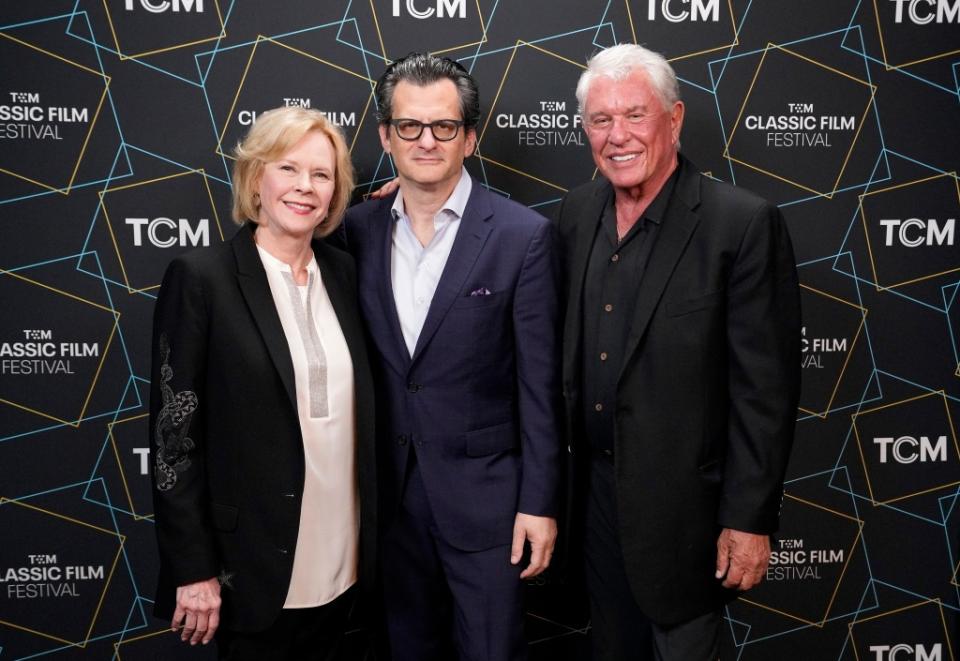
In the conversation preceding the closing screening of “The Big Chill,” Berenger and Williams recounted how director and co-writer Lawrence Kasdan had the ensemble cast rehearse for four weeks in L.A. before heading out to Atlanta and finally Beaufort, S.C. for the shoot, improvising college-era backstories for their characters. That didn’t mean that any of that improvisation was incorporated into the screenplay once filming began. “There were a few little changes here and there, but, I mean, we couldn’t improvise while we were shooting,” said Berenger. “He wanted the lines as written, and with good reason.”
Williams said that “we had had fun. It was freezing when we did that outside kissing, but we managed to do it,” she said of the sequence near the end that involves some adulterous snogging between their characters. “Yeah, we got through it somehow,” Berenger said.
Berenger said he considered “The Big Chill” to be the closing bookend of films about the baby boomer generation, with “The Graduate” being the opening bookend. Williams said commercial expectations for the movie were extremely low: “Nobody wanted to make the movie too much, and finally, Johnny Carson’s production company agreed to do it. So we had no idea. The studio (Columbia) did not think they had any kind of movie on their hands. They thought, little movie, maybe it’s charming, whatever, until it won the people’s choice award at the Toronto Film Festival and suddenly they went, ‘Oh my goodness,’ and then they started advertising it.”
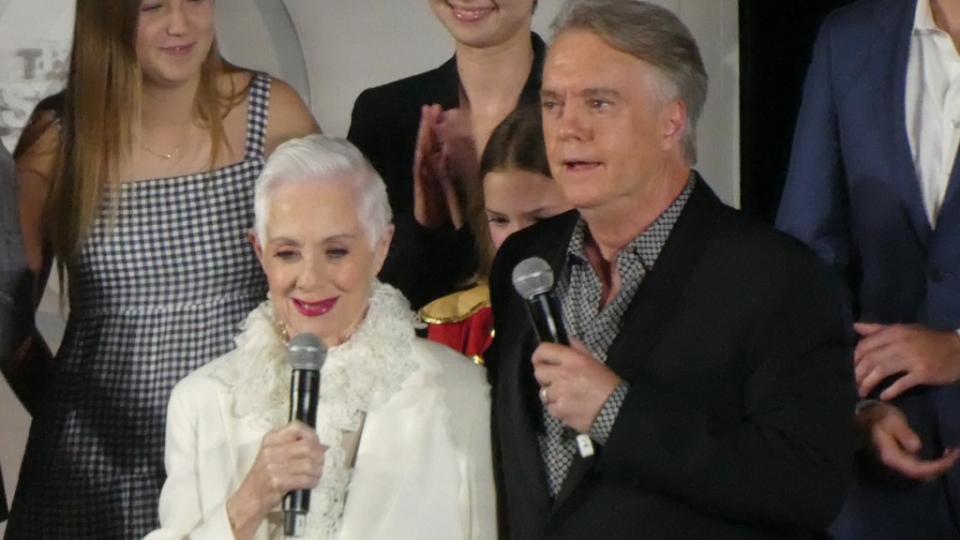
Shirley Jones did not do a Q&A, per se, after “The Music Man” wrapped up early Sunday evening — but she did do a full-on family reunion on stage. Before the veteran performer came out, one of her sons, one-time pop idol Shaun Cassidy, spoke at some length about the family’s experience of the movie, including his own; his mother had taught him to ride a bicycle, he said, on the part of the Warner back lot where the movie’s “Trouble” sequence was shot.
He also spoke about his brother Patrick, who is mounting a stage production and was unable to attend, being in their mother’s womb at the time of shooting, as the filmmaking team went to increasingly greater lengths to hide the pregnancy. At an advanced stage of filming, Cassidy said, Shirley Jones and Robert Preston were shooting a climactic clinch on a footbridge when Preston felt a jolt and said, “What was that?” It was Patrick Cassidy, kicking. Later on, Patrick as an adult encountered Preston and the latter said, “We’ve already met.”
“I’m really thrilled to be here,” said Jones, who just turned 89 at the end of March, when her time on stage came. And it was hard to imagine anyone wouldn’t be after sitting with an audience that erupted in explosive applause at the close of every one of her musical numbers. Shaun Cassidy made it appear as if his mother had been on the fence about coming, until the possibility that her entire extended family could attend with her arose. “When I said they were gonna screen the movie, she said, ‘You know, I’ve seen the movie.’ I said [dryly], ‘Yeah, I know. But I think they want to honor you.’ And she said, can the grandchildren come? And then it all happened.”
Best of Variety
Sign up for Variety’s Newsletter. For the latest news, follow us on Facebook, Twitter, and Instagram.
